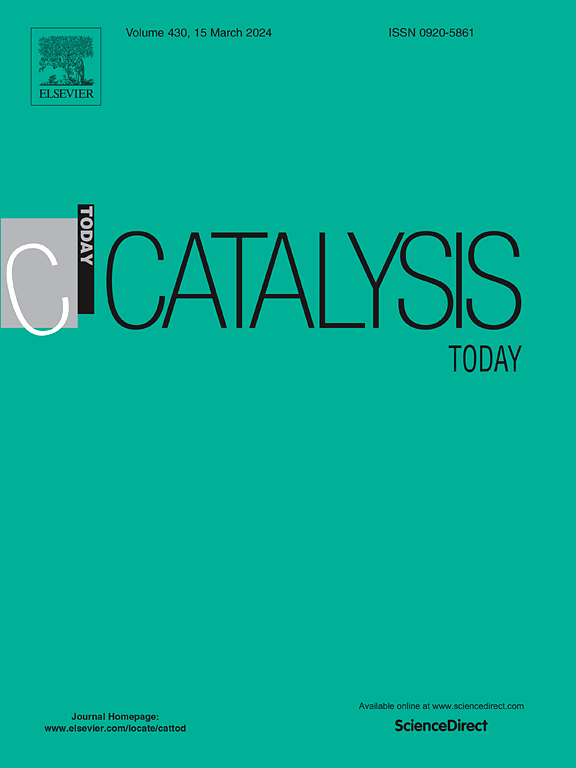微波冲击铁掺杂碳纳米管:聚丙烯热解制备ORR催化剂的可回收性
IF 5.2
2区 化学
Q1 CHEMISTRY, APPLIED
引用次数: 0
摘要
通过热解将废塑料回收利用并转化为高价值产品是一项严峻的挑战,因为它存在耗时/耗能的问题,而采用微波辅助催化热解技术则可以克服这些问题,因为微波辅助催化热解技术具有热解速度快、产品收率高的特点。本研究提出了一种利用热解产物作为原料,合成用于微波辅助热解废塑料催化剂的简便方法。在这种情况下,开发了一种微波热冲击策略,可有效地将纳米铁粒子锚定在碳纳米管(CNT)上。这种方法将部分热解产物回收到催化剂池中,用于塑性变换成新的 CNT,从而减少了制备额外催化剂的消耗。在 50 W 微波辐照下,前驱体在几秒钟内就能达到 2000 ℃ 以上,从而使铁纳米粒子均匀地浸渍在碳纳米管基质中。形成的掺铁碳纳米管在微波辅助热解中表现出很高的活性,生成的碳纳米管的D/G比为0.31。经过多次热解后,碳纳米管的循环和重构形成了交叉衬砌的网络结构,有利于电子过渡,可用于制造电催化剂。氮掺杂进一步将起始电位提高到 0.923 V(相对于 RHE),使其成为氧还原反应中电催化应用的可行候选材料。总之,我们的研究结果表明了这种方法的可行性,它可以将反应性热解产物用作微波辅助热解的催化剂,并有可能减少挥发性有机化合物的排放和催化剂制备的资本支出,为塑料废物管理和催化剂生产提供了一条更环保、更高效的途径。本文章由计算机程序翻译,如有差异,请以英文原文为准。
Iron-doped carbon nanotubes via microwave shock: Recyclability in polypropylene pyrolysis for ORR catalyst manufacturing
The recycling and upcycling of waste plastics into high-value products by pyrolysis is a critical challenge caused by its time/energy-consuming problems, which can be overcome by employing microwave-assisted catalytic pyrolysis due to its rapid pyrolysis rates and high product yields. This study presents a facile method for the synthesis of catalysts for microwave-assisted pyrolysis of waste plastics, utilizing the pyrolytic products as raw materials. In this case, a microwave thermal shock strategy is developed to efficiently anchor iron nanoparticles on carbon nanotubes (CNTs). This method recycles a portion of pyrolysis products back into the catalyst pool for plastic transformation into new CNTs, reducing the consumption for preparing additional catalysts. The precursors exposed to 50 W microwave irradiation reaches above 2000 °C within seconds, allowing Fe nanoparticles to be uniformly impregnated within the carbon nanotube matrix. The formed iron-doped CNTs shows high activity for microwave-assisted pyrolysis, generating CNTs with D/G ratios at 0.31. The recycling and reconstruction of CNTs after multiple pyrolysis form a cross-lined network structure, which facilitates electron transition and can be utilized for fabricating electrocatalysts. Nitrogen doping further improves the onset potential to 0.923 V vs. RHE, making them viable candidates for electrocatalytic applications in oxygen reduction reactions. In summary, our findings demonstrate the feasibility of this approach to reactive pyrolysis products that serve as catalysis for microwave-assisted pyrolysis, with the potential to reduce volatile organic compound emissions and capital expenditure in catalyst preparation, offering a greener and more efficient pathway for plastic waste management and catalyst production.
求助全文
通过发布文献求助,成功后即可免费获取论文全文。
去求助
来源期刊

Catalysis Today
化学-工程:化工
CiteScore
11.50
自引率
3.80%
发文量
573
审稿时长
2.9 months
期刊介绍:
Catalysis Today focuses on the rapid publication of original invited papers devoted to currently important topics in catalysis and related subjects. The journal only publishes special issues (Proposing a Catalysis Today Special Issue), each of which is supervised by Guest Editors who recruit individual papers and oversee the peer review process. Catalysis Today offers researchers in the field of catalysis in-depth overviews of topical issues.
Both fundamental and applied aspects of catalysis are covered. Subjects such as catalysis of immobilized organometallic and biocatalytic systems are welcome. Subjects related to catalysis such as experimental techniques, adsorption, process technology, synthesis, in situ characterization, computational, theoretical modeling, imaging and others are included if there is a clear relationship to catalysis.
 求助内容:
求助内容: 应助结果提醒方式:
应助结果提醒方式:


